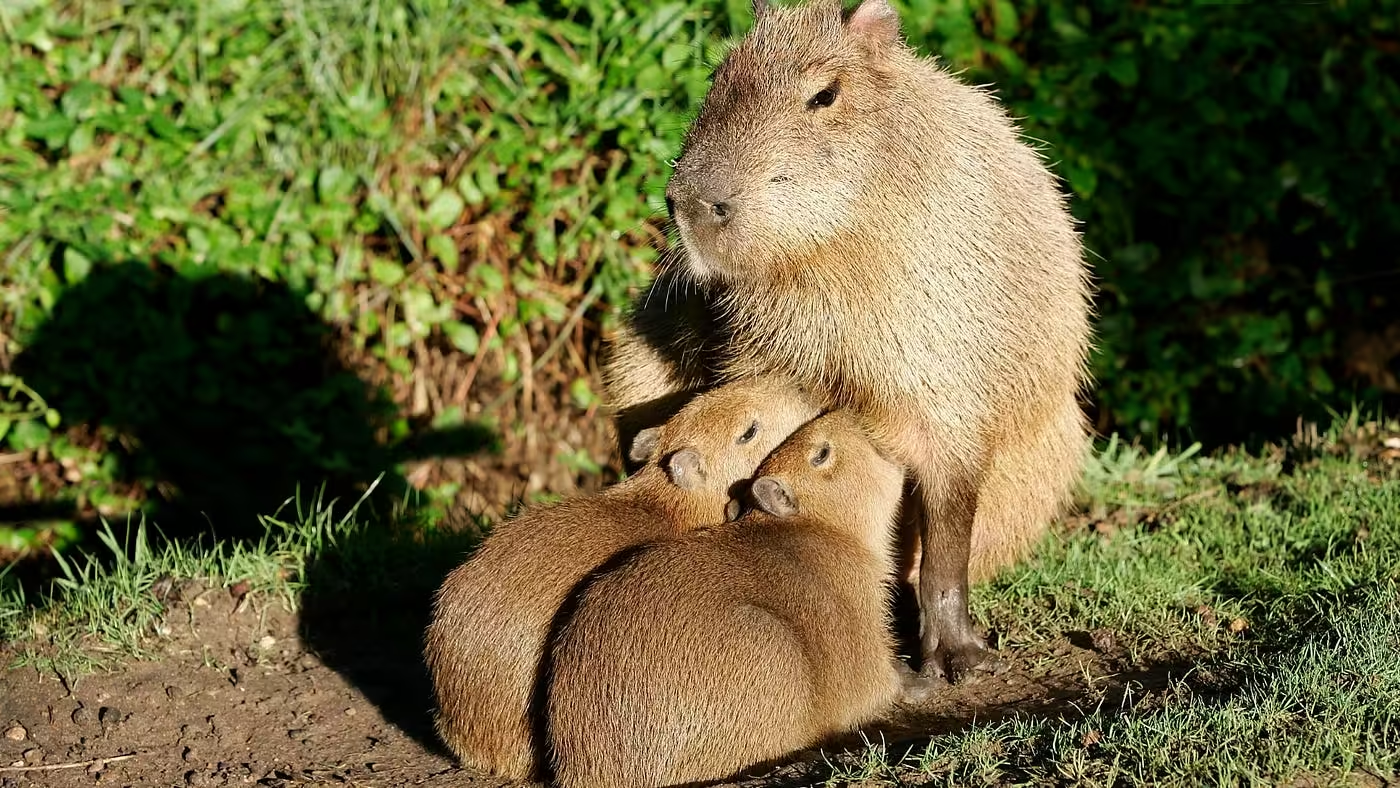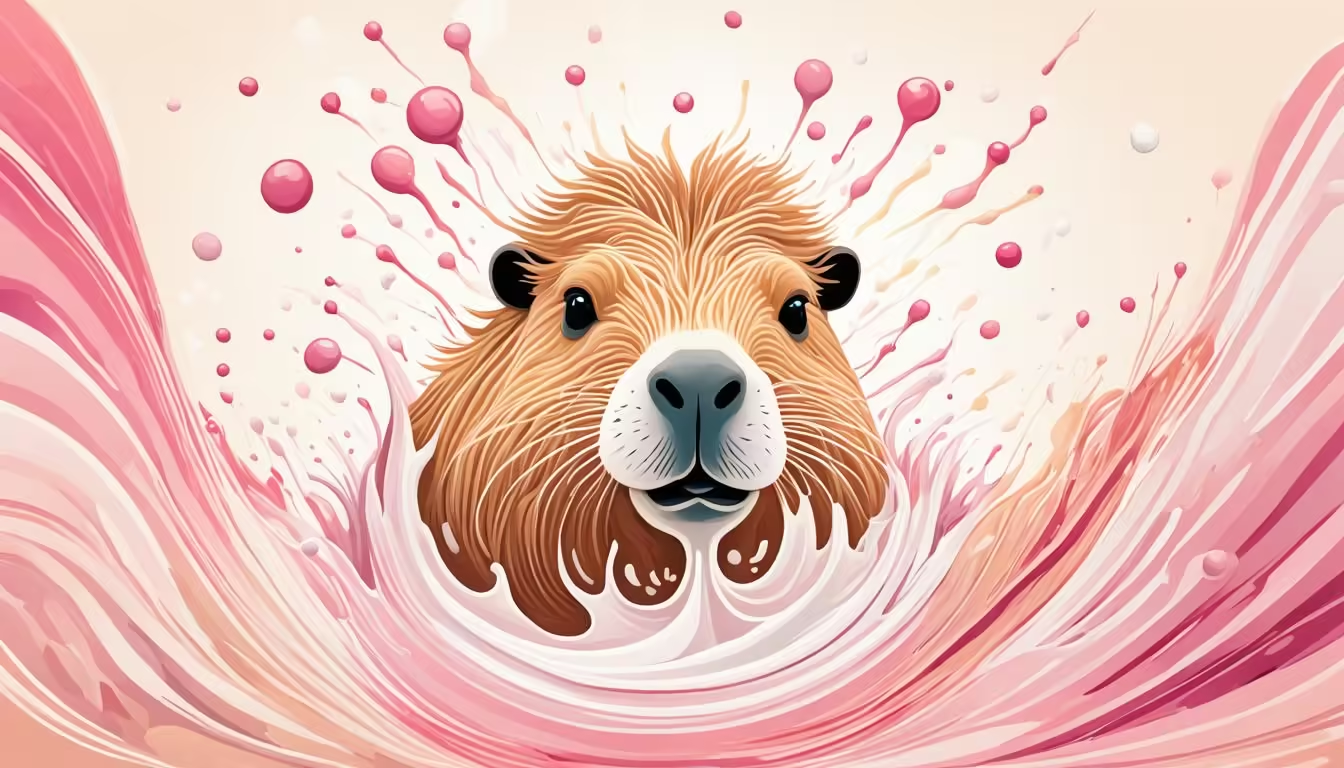These semi-aquatic mammals are like guinea pigs but much larger.
They are known for sleeping in water, swimming a lot, and even being “furniture” for other animals. This makes them quite interesting.
Key Takeaways
- Capybaras are the largest rodents in the world, weighing up to 150 pounds.
- They are semi-aquatic mammals native to South America, living near bodies of water.
- Capybaras are closely related to guinea pigs and have a unique set of behaviors.
- Capybaras feed on milk for the first 16 weeks of their lives, regardless of which mother in the group they suckle from.
- Capybaras are herbivores, consuming a diet of aquatic plants, grasses, barks, tubers, and sugar cane.
They live in water and are part of the cavy family, which includes guinea pigs and rock cavies.
Capybaras as the Largest Rodents
Capybaras can be as long as 51 inches and as tall as 20 inches. They weigh between 60 to 174 pounds. This makes them the biggest rodents around.
Capybaras’ Semi-Aquatic Lifestyle
- Capybaras are perfect for life in water. They have webbed feet and can hold their breath for up to 5 minutes.
- They live in rivers, lakes, and swamps. They eat aquatic plants and grasses.
- Their special features help them avoid predators and move through the water easily. This makes them interesting to study.
Capybaras are amazing creatures. They catch the interest of scientists and nature lovers with their size and water skills. Learning about them helps us appreciate the natural world more.
Do Capybaras Drink Milk?
Capybaras, the biggest rodents, have a special bond with milk. In the wild, their babies drink milk from their moms for 16 weeks. But, when they grow up, they can’t drink milk anymore because they become lactose intolerant.
Milk Consumption in the Wild
Newborn capybara babies need their mom’s milk a lot. They will drink from any female that has milk in their group, not just their mom. This helps make sure all the babies get enough food early on.
Pups and Suckling
By the time they are 3 months old, capybara babies start eating plants and grasses. They can digest these foods better, so they don’t need milk as much. They slowly start eating solid food but still suckle sometimes.
“Over 12 years spent in the company of capybaras, observing them intently and learning about them.”
Capybaras show how important milk is for young ones and how they adapt to eating plants as adults. Knowing this helps us take better care of them, whether they are in the wild or in captivity.
Milk Replacers for Baby Capybaras
Caring for baby capybaras needs special knowledge and attention, especially about their diet. Since capybara pups can’t have cow’s milk, there’s a special milk formula for them. This formula is called the Wombaroo Capybara Milk Replacer.
Wombaroo Capybara Milk Replacer
The Wombaroo Capybara Milk Replacer is a special milk powder. It’s made to give capybara pups the right mix of nutrients they need. It has more protein and fat than other milk formulas, helping the pups grow strong.
It’s suggested to feed this capybara milk replacer until the pups are about 3 months old. At that time, they should start eating solid foods. This special diet is key to keeping these animals healthy and happy when they’re young.
| Nutrient | Amount per Liter of Prepared Milk |
|---|---|
| Protein | 83g |
| Fat | 49g |
| Carbohydrate | 42g |
| Ash | 6% |
| Moisture | 4% |
| Energy (ME) | 3.9MJ |
Using the Wombaroo capybara milk replacer makes sure capybara pups get the nutrients they need. This helps them grow and develop well in their early life.
Zoologic Milk Matrix for Capybaras
The Zoologic Milk Matrix 42/25 is a top choice for raising baby capybaras. It’s a milk replacer designed to match the nutrients found in any mammal’s milk, including capybara milk.
This milk replacer has low lactose levels, perfect for capybara pups. You can use it alone or mix it with other Zoologic products. This way, you can make a milk replacer that meets the capybara’s specific needs. It helps young capybaras grow and develop properly by mimicking the natural milk’s composition.
| Nutrient | Concentration in Capybara Milk | Concentration in Zoologic Milk Matrix 42/25 |
|---|---|---|
| Protein | 10.4 g/100 mL | 42 g/100 g |
| Fat | 6.9 g/100 mL | 25 g/100 g |
| Lactose | 4.4 g/100 mL | Low |
The Zoologic Milk Matrix 42/25 is made to match the natural milk of capybaras. This ensures that capybara pups get the nutrients they need for growth and health. It’s a reliable and effective milk replacer for raising capybaras in captivity.
Other Milk Options for Capybara Pups
Specialized Wombaroo and Zoologic milk replacers are best for baby capybaras. But, some pups have thrived on goat, sheep, or horse milk powders too. These aren’t made just for capybaras, but they can work if the special formulas are hard to find. It’s key to watch the pup closely to make sure it doesn’t have any stomach problems.
Goat, Sheep, and Horse Milk Powders
Goat, sheep, and horse milk powders can be an alternative capybara milk for pups in need. They’re not made just for capybaras, but they can be used if the special milk is not available. It’s important to watch the pup to see if it can digest and use these goat milk capybara or sheep milk capybara well.
- Goat milk powder: Has a similar fat and protein level to capybara milk, making it a good choice.
- Sheep milk powder: Has more fat and protein than capybara milk, so watch how the pup’s stomach handles it.
- Horse milk powder: Has a different mix of nutrients than capybara milk, so how well it works can vary with each pup.
Choosing these alternative capybara milk options should be talked over with a vet or capybara expert. They can help decide the best supplements for the pup’s health and happiness.
Probiotics for Capybara Digestive Health
Capybaras, the largest rodents, face digestive issues like capybara diarrhea and capybara constipation. These problems can be serious if not treated. Luckily, a probiotic supplement can help with these capybara digestive issues.
Bene-Bac for Diarrhea and Constipation
Bene-Bac is a probiotic made just for capybaras. It has good bacteria that can fix the balance in their gut. This helps with symptoms of diarrhea and constipation. Capybara probiotics like Bene-Bac are key for their digestive health.
If a capybara has ongoing digestive problems, see a vet. The vet can tell you how much capybara probiotics to give and check for other health issues. Taking care of capybara digestive issues early helps keep capybaras healthy for a long time.
| Probiotic Supplement | Key Features | Benefits for Capybaras |
|---|---|---|
| Bene-Bac |
|
|
“Keeping a capybara’s digestive system healthy is key. Probiotics like Bene-Bac are crucial for their gut health.”
Dietary Requirements for Adult Capybaras
Capybaras are the biggest rodents in the world. They need a special diet to stay healthy and live their semi-aquatic life. They eat mostly aquatic plants, grasses, barks, tubers, and sugarcane in the wild. To keep adult capybaras in captivity healthy, it’s key to feed them like they would forage in nature.
These animals need a diet rich in fiber but low in nutrients, just like their wild food. They should have lots of fresh grass and hay, like Orchard Hay and Timothy Hay. This keeps their teeth healthy and them well. They also need guinea pig or rabbit pellets for important nutrients.
Kapi’yva Exotics, a top wild animal breeder, says don’t give capybaras fruits, veggies, or sugary foods every day. These can upset their stomach and cause health problems.
For their gut health, probiotics like Benecol in America and Bio 3 in Japan are good. The Bene-Bac probiotic is also a favorite among capybara owners for keeping their poop right.
| Dietary Requirement | Recommended Quantity |
|---|---|
| Fresh Grass and Hay | Unlimited Access |
| Guinea Pig or Rabbit Pellets | Supplemental |
| Fruits and Vegetables | Occasional, Limit High-Sugar Items |
| Probiotics (Benecol, Bio 3, Bene-Bac) | As Needed for Digestive Health |
By sticking to these dietary tips, you can make sure your adult capybara gets the right food. This helps them stay big, live their semi-aquatic life, and stay healthy and happy.
Consequences of Improper Diet
Feeding capybaras too much sugar, fat, and junk can lead to early death. Many have died young because of diet-related health issues. It’s key to feed them hay, grass, and special pellets, with only a bit of fruits and veggies.
Premature Death and Health Issues
Capybaras have been eating a special diet for 30 million years. They eat a lot of grasses and spend a lot of time grazing. But, if pet capybaras eat too much sugar and junk, they can get serious health problems like tooth issues, bloat, and even die too soon.
It’s important to talk to experts who know about capybaras to make sure they get the right food. This helps avoid these big health problems.
Sugar and stress are big risks for capybaras. That’s why breeders don’t sell them as pets anymore because it’s hard to feed them right. To keep a capybara healthy, give them fresh grass, hay, and special pellets. Only give them a little bit of fruits, veggies, and sweets.
FAQ
What are the unique characteristics of capybaras?
How do capybaras obtain their nutrition?
Do capybaras drink milk?
What milk replacers are suitable for baby capybaras?
How can probiotics help capybaras with digestive issues?
What are the consequences of feeding capybaras an improper diet?
Source Links
- 10 Facts About Capybaras: The World’s Largest Rodents
- Baby Capybara
- Capybaras enjoy hot springs
- Facts About Capybaras
- What Should I Feed My Pet Capybara? Capybara Diet
- Capybaras
- Capybara in Captivity – Capybara
- Baby Capybara – Capybara
- Baby Capybara Milk Formula – capybaraworld
- The Best Milk Replacement Formulae for Baby Capybaras Who Have To Be Bottle-Fed
- Reproductive Technologies Used in Male Neo-Tropical Hystricomorphic Rodents
- Milk Transmission of Mammalian Retroviruses
- I Visited Seoul’s Most Insane Pet Cafes, from Capybaras to Meerkats
- Capybara
- EMA and EFSA Joint Scientific Opinion on measures to reduce the need to use antimicrobial agents in animal husbandry in the European Union, and the resulting impacts on food safety (RONAFA)
- Abstracts of Scientific Presentations: 2020 AALAS Virtual National Meeting
- Abstracts of Scientific Presentations: 2020 AALAS Virtual National Meeting
- Capybara Diet. Includes Treatments For Dietary Health Issues. 水豚飲食. カピバラダイエット
- What Do Capybaras Eat
- Capybara diet – capybaraworld
- Capybara diet – capybaraworld



